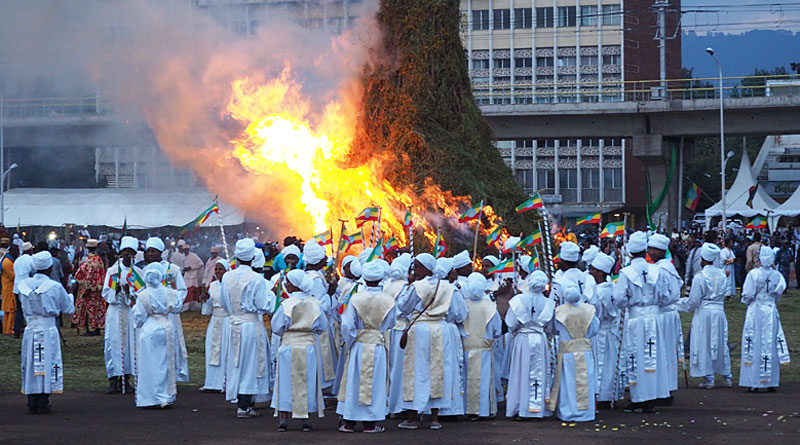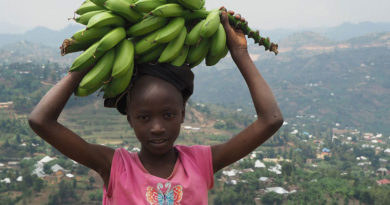Meskel: Ethiopia’s festival of fire
Nothing was going to stop me seeing one of Africa’s most colourful festivals.
Well, almost nothing. Two rows of stony-faced policemen standing shoulder-to-shoulder across the road seemed determined to do just that.
It was the eve of Meskel in Addis Ababa, Ethiopia’s sprawling capital, and all over the country people were preparing for a night unlike any Christian festival in the west.

I’d hurried back from visiting the extraordinary rock-hewn churches at Lalibela — a grueling two-day trip by bus — to make sure I could experience the festival on Meskel Square, focal point of the nation’s celebrations.
Meskel 2016, however, was taking place in the shadow of Ethiopia’s worst political violence since the government came to power 25 years earlier. Hundreds had died and city officials weren’t taking any chances.
For days they’d been warning people to avoid the city centre; that afternoon all five roads converging on the square were blocked by lines of policemen.
Getting past them involved a full frisking — never have I been so intimately examined by so many men — and a full bag search. Ten metres further a second line of khaki-clad, humourless police were waiting to repeat the procedure.

I breezed through the first cordon but at the second a particularly sour officer jabbed at my camera and said it wasn’t permitted.
That was clearly bullshit. I knew that in a few hours’ time Meskel Square would be packed with tens of thousands of people taking selfies. In fact, I thought I could already see a few people snapping photos on the other side of the police lines.
The officer wasn’t impressed with my arguments, however. You can’t reason with a policeman in Ethiopia the same way you can hold a spirited debate with a cop in small-town New Zealand.
I slunk off dejected but determined to find another way in.
I pushed my way through the crowds jamming the back streets to another of the avenues leading to the square. This time I went straight up to the most senior officer, judging by the number of stripes on his epaulettes, and showed him my camera.
He waved me through with barely a glance but a lower-ranked officer in the next line refused to let me any further. I went back to his superior to appeal, to no avail.
“Go back,” he ordered, in a tone that left no room for argument.
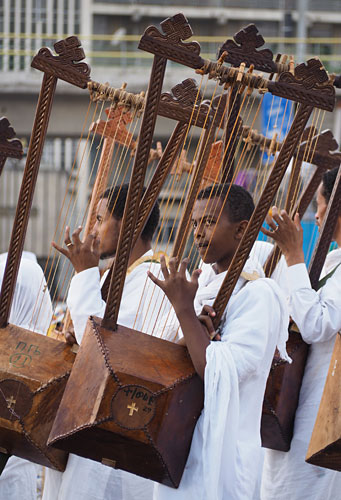
I was also rebuffed at the third cordon, where a particularly disagreeable officer pulled a water bottle from my bag and threw it on the road, but at the fourth cordon I had better luck.
This time I struck a policeman who seemed more interested in knowing what a faranji (foreigner) keeps in his bag than exercising power.
I took out every item and demonstrated it at length; the only thing that aroused suspicion was a data cable. After a bit of miming I convinced him that that, too, was innocent, and he let me through. I could have hugged him.
When I finally reached the square a few thousand people were already milling about on the viewing terraces. I picked a spot in the crowd with a reasonable view, not easy when you’re standing among one of the tallest nations on earth.
At first all I could see was a few hundred priests dressed in brightly coloured robes, turbans and embroidered hats. Most were holding staffs topped with silver crosses; a few were swinging censers billowing clouds of incense.
The dignitaries — including the mayor of Addis Ababa and the Patriarch of the Ethiopian Orthodox Church, in a golden crown and robes — were seated on a dais along one side of the square, while in the centre stood a towering spire of dry grass and straw on a timber frame. The tower was topped with the yellow daisy-like flowers that blanket the Ethiopian countryside in the weeks leading up to Meskel.
Slowly the square filled with people. The first waves appeared to be church groups, dressed in white robes, singing hymns, chanting to the beat of colourful skin drums and waving a forest of Ethiopian flags.
They were followed by a mass of musicians plucking traditional wooden harps and playing the masinko, an ancient single-stringed fiddle.
Next came more priests, sheltering gilt-framed icons under ornate parasols and carrying a cardboard Ark of the Covenant, and floats draped in the Ethiopian colours of red, green and gold.
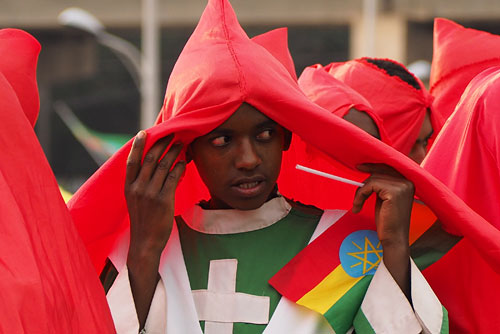
More and more people kept flooding into the square from every direction as the singing, drumming and clapping picked up in tempo. I was so absorbed by the spectacle it took me a while to notice a soldier on the square pointing at me and gesticulating energetically.
I thought I’d finally been busted by the camera police. I was about to get evicted from a festival I’d worked so hard to get into.
I tried to disappear into the crowd but, as a blonde-haired European in a sea of Ethiopians, it was hopeless.
In any case my fellow festival-goers had cleared a path and dozens of hands were propelling me forward.
It was only when I reached the front that I realised this soldier was smiling, not scowling. He was also pointing at an empty seat in the closely guarded VIP section where rows of concrete benches offered uninterrupted views of the celebrations.
Still people kept flooding into the square, joining the great swirling mass of devotees already circling the straw tower at the centre of the square. By the time I reached my seat they numbered in the thousands.
As dusk descended on the city the drumming and singing reached a crescendo and a priest strode forward with a burning torch.

Soon flames were licking up the side of the spire. The fire took hold quickly, sending a column of dark smoke into the sky. As the flames rose higher the heat forced the dancers to back away; soon the square was all but empty. I could feel the intense heat even where I was sitting.
Earlier in the evening priests had waded through the crowd handing out candles. As the bonfire was lit so too were many thousands of candles, turning the terraces into a sea of flames.
A hush fell as the bonfire slowly crumpled, throwing up showers of sparks, and thousands of people held out their hands, their cupped palms turned upwards, in prayer.
And somewhere in the crowd a stray white guy said his own prayer of thanks that he’d been able to witness a festival unlike anything he’d seen before.
Click here to see more photos of Meskel…
What is Meskel?
The Ethiopian festival of Meskel celebrates the discovery in the 4th century AD of “the True Cross” — the cross on which Christ was crucified — by the Roman Empress St Helena.
St Helena was the mother of the Emperor Constantine the Great, who ruled Rome from 306-337 AD and famously made Christianity the empire’s official religion.
She is revered by Christians for shaping her son’s religious beliefs and, according to legend, travelling to Jerusalem and finding the True Cross around the year 320 AD.
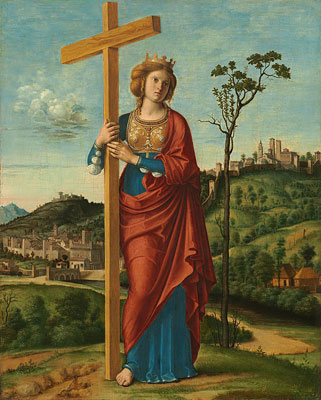
In Ethiopian tradition St Helena, or Queen Eleni, had a revelation one night that she should build a bonfire. The smoke, she was told, would show her where the True Cross was buried.
The following day she ordered the people of Jerusalem to bring wood and build a huge bonfire. When she added frankincense a column of smoke rose high into the sky, then abruptly changed direction and returned to the ground. The True Cross was found buried at the spot where the smoke touched the earth.
In the Ethiopian calendar Meskel falls on Meskerem 17, which is September 27 or 28 in the Western calendar. It is celebrated the evening before by building bonfires, called demera, topped with Meskel daisies, a flower that turns the Ethiopian highlands yellow every September.
Celebrations are held all over Ethiopia with particularly lively events in the northern town of Lalibela and on Meskel Square in the centre of the capital, Addis Ababa.
Meskel simply means ‘cross’ in Ge’ez, the ancient liturgical language of the Ethiopian Orthodox Church.
In the other Orthodox, Catholic and Protestant churches Meskel is known as the Feast of the Exaltation of the Holy Cross and is celebrated on September 14.

